The Propaganda Machine
The propaganda machine worked at all levels of the Soviet society. The Central and regional committees of the Communist Party had an Отдел агитации и пропаганды [Otdel agitatsii i propagandy] or Department for agitation and propaganda, abbreviated to агитпроп [agitprop]. Propaganda was supposed to work on the minds, while agitation had to focus on emotions.
The ideas to be disseminated were those of communism, including explanations of the policy of the Communist Party and the Soviet state. In other contexts, propaganda could mean dissemination of any kind of beneficial knowledge, like new working methods in agriculture.
Schools and youth organisations
In schools and youth organisations like the Pioneers and Komsomol the children and young people were «liberated from bourgeois ideas». The intention was to «indoctrinate the next generation with a collective way of life». The idea that the education of the children was the responsibility of their parents was explicitly rejected. Children are «like soft wax, very malleable, and they should be cast into good Communists». To those who were born after the revolution, was explicitly told that they had to help to build an Utopia of brotherhood and justice which had to be totally red.
The Young Pioneers, the movement for the youngest, was a major factor in the indoctrination of children. They were taught to honestly and uncompromisingly counter «the enemies of socialism». At the schools marches were conducted, the kids sang songs and made promises of loyalty to the Soviet leadership. The children had the feeling that they were involved in a world revolution, which was more important than family ties.

Cover of Rules of life for Young Pioneers
The story of Pavel Trofimovich Morozov (1918-1932), better known by the diminutive Pavlik, is typical for this idea. Morozov was a boy who had betrayed his father to the secret police NKVD. He and his brother Fyodor were found murdered in a forest near Gerasimovka on September 3, 1932. The truth about the murder was difficult to determine, because the case was politicized immediately. Probably Pavlik's family had nothing to do with the murder. According to British historian Orlando Figes, the boys were probably assassinated by a nephew after a quarrel about a weapon. Nevertheless, five family members were indicted, among whom Pavlik's grandparents, after allegations coming from the very same cousin. During a show trial, in the presence of the whole Soviet press, four of them were sentenced to the firing squad and then executed.
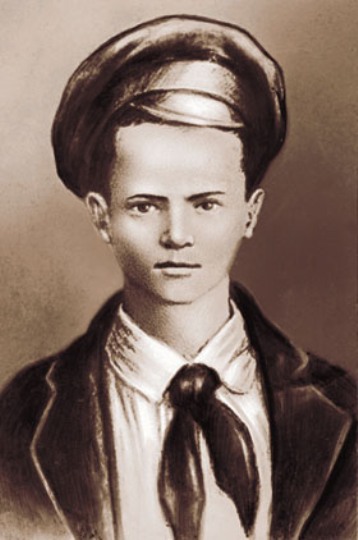
Pavlik Morozov
The murder of Pavlik and Fyodor Morozov was depicted by the Soviet press as a political crime with Pavlik in the role of the innocent Pioneer model and the murderers as «counterrevolutionary kulaks». So he quickly grew into a hero of a propaganda cult, which began in the autumn of 1933. Stories, movies, plays, biographies, songs: Pavlik Morozov was repeatedly honoured as the perfect Pioneer, a vigilant party activists at the home front. The selfless courage he had shown by sacrifying his own father was presented as an example for all children in the Soviet Union.
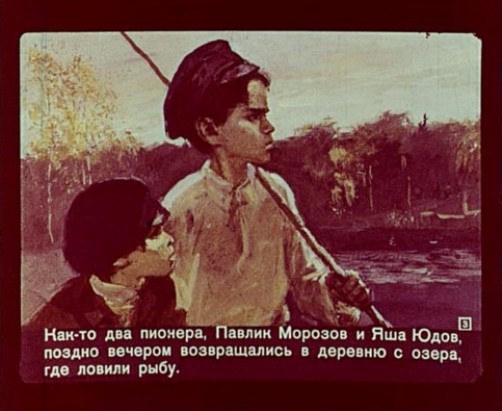
Frame from an animation film about Pavlik
Radio
A commonly used propaganda tool was the radio, especially to reach the illiterate. Radios were installed in common locations, where the farmers had to come to hear the news about changes in the rationing, and in libraries, schools, offices and workshops. These locations were also used to spread propaganda posters.
Propaganda posters
While posters were already used in Russia before the Revolution, they were completely overshadowed by the remarkable propaganda posters of the Soviets. In the early days of the Soviet Union, posters were widely used, often showing images of the Red Army, triumphant in favor of the illiterate.
The revolution coincided with a period of many radical artistic expressions in Western culture, such as Futurism, Constructivism, Surrealism and Dada. Especially in the early years, the propaganda posters in the Soviet Union were affected by these movements.
The production of the posters was led by Yakov Timofeevich Ruklevsky (1884-1964), who recruited a remarkable group of recently graduated designers. Most famous were the brothers Vladimir Avgustovich (1899-1982) and Georgy Avgustovich Stenberg (1900-1933), who depicted dynamic images of the chaotic spirit of the time. Other recruits of Ruklevsky were Nikolay Petrovich Prusakov (1900-1952), Josif Vasilyevich Gerasimovich (1893-1982), and the fertile Mikhail Oskarovich Dlugach (1893-1985), who designed over 500 posters.
One of the most remarkable developments during the period of the Five-Year Plans was the cooperation between Vladimir Vladimirovich Mayakovsky (1893-1930) and Aleksandr Mikhailovich Rodchenko (1891-1956) as advertising designers for the state. They developed an agitational propaganda style in which shrill screamings and aggressive compositions with strong diagonals and colors became the peacetime equivalent of the revolutionary poster.
A master in this area was Gustav Gustavovich Klutsis (1895-1944), a constructivist artist who used techniques of the '20s as a visual celebration of the plan and the new society. His colours were simple, often only red and black, but his compositions were very dynamic and with a bold typography.
Propaganda films
The years of the New Economic Policy also gave the film industry in the Soviet Union a strong impetus. Thousands of cinemas were built and hundreds of films were produced. Sovkino, the national film institute, funded the masterpieces Battleship Potemkin and October made by Sergey Mikhailovich Eisenstein (1898-1941). The bold use of new techniques such as photomontage, double images, cross cutting, split screens and freeze frames had even a great influence on western cinema.
Thousands of propaganda films were shown in theaters and on special propaganda trains. From 1940, weekly newsreels were also shown in subway stations, so that those who could not pay for a cinema ticket would not be excluded.
The Propaganda Train
A unique institution was the propaganda train, equipped with presses and portable cinemas, and manned with teachers, artists and actors. They were mainly used from 1940 to show propaganda films against Nazi Germany. In the tenth episode of the TV series Master i Margarita by Vladimir Bortko some authentic images of a propaganda train are shown to illustrate a speech in which the failing action by the Soviet authorities against Woland's gang is presented as a success.
Meetings
All over the country meetings were held. Despite their boredom, they created a sense of solidarity for many people, since the fact of being kept informed of new developments made them feel important.
Lectures
Lectures were used to keep the citizens properly instructed on virtually every aspect of life. Stalin's own lectures on Leninism were organized to demonstrate that the Party was the cornerstone of the October Revolution.
Scene from Heart of a Dog
Arts
The literature, the visual arts and the performing arts also needed to serve propaganda purposes according to the Soviet government. Moreover, they had to show a clear and unambiguous meaning. The art was confined to such limited role, cultural activities were subject to censorship and to a monopoly of cultural institutions.
In 1928, when the first Five Year Plan was proclamed, a Социальный заказ [sotsialny zakaz] or social mission was assigned to writers. They were each given a specific theme with the aim of promoting the socialist society building. The theme committed to Ivan Bezdomny in The Master and Margarita was atheism. The leaders of the Union of Soviet Writers supported the use of historical themes, at least insofar as they were written with the correct Marxist vision
Bulgakov specifically criticises this social mission in The Master and Margarita when his hero, the master, remembers that the editor to whom he had shown his manuscript asked «a totally idiotic question» about who had given him the idea of writing a novel on «such a strange theme». A novel about Pontius Pilate was clearly not part of his social mission.
The ideology of the Communist Party wanted to influence the creative process from the first moment of artistic inspiration. The party was the muse of the artist. In 1932, the Social Realism was introduced as the only acceptable aesthetic form. The merits of a work were measured by the extent to which it contributed to «the construction of socialism to the masses». The visual arts also had to show a heroic realism. The Soviet pavilion for the World Fair in Paris in 1937 showed the famous 24 meters high monumental sculpture of The Worker and the Kolchoze Woman by Vera Ignatyevna Mukhina (1889-1953).
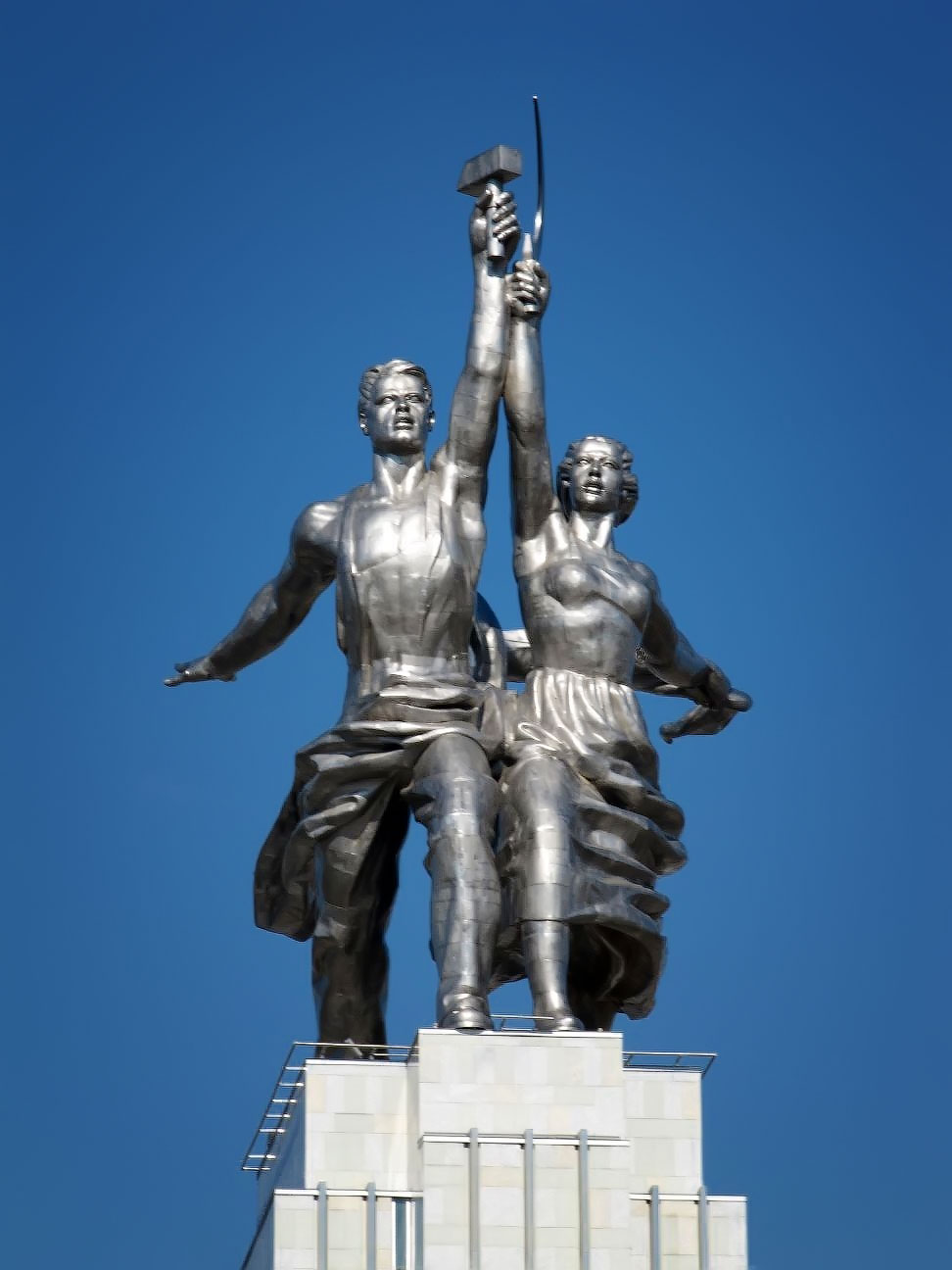
The Worker and the Kolchoze Woman
Art was filled with health and happiness. Busy industrial and agricultural scenes teemed in paintings, and in sculptures were pictured workers, soldiers and schoolchildren. A good example are the images of Matvey Genrichovich Manizer (1891-1966), which can still be seen in the subway station Площадь Революций [Ploshchad Revolutsy] or Revolution Square in Moscow.
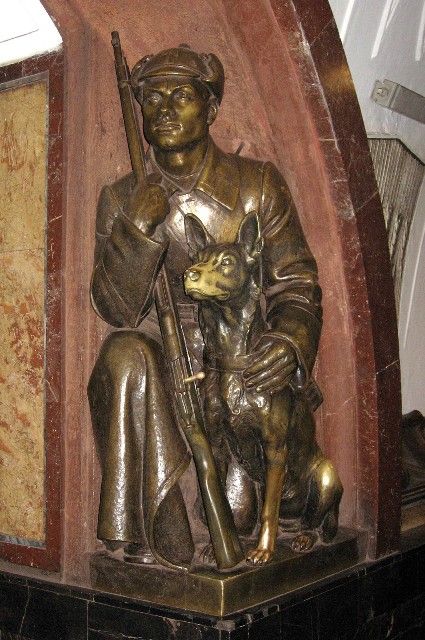
Revolution Square Metro Station
Newspapers
In 1917, when they left their underground movements, the Communists began with the publication of Правда [Pravda] or The Truth. One of the very laws they introduced when they came to power was aimed at crushing the newspapers which were against them. In 1918, the independent press, including many journals from the eighteenth century, were gagged.
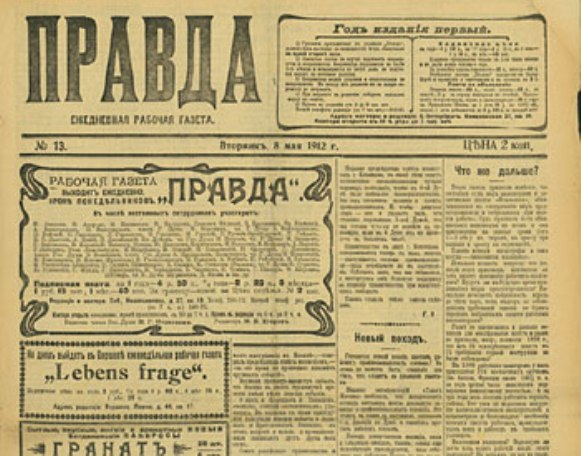
Issue number 13 of the Pravda
From 1930 to 1941, the propaganda magazine СССР на стройке [SSSR na stroyke] or USSR Under Construction was published. It existed in Russian, French, English and German and, from 1938, also in Spanish. The self-proclaimed goal of the magazine was to present «a picture of the entire scope and variety of the current constructions of the Soviet Union». It focused on an international audience, especially Western left wing intellectuals and businessmen, and had the writers George Bernard Shaw (1856-1950) and Herbert George Wells (1866-1946) among its subscribers.
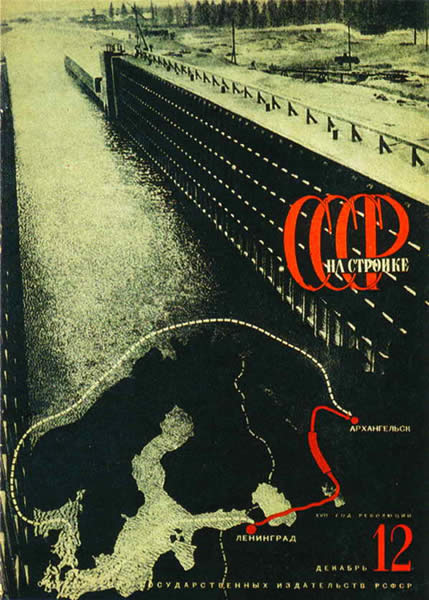
Issue number 12 of The USSR Under Construction
Books
Immediately after the revolution, books were treated less severely than newspapers, but the nationalization of the printing and publishing companies brought them under control. Libraries were purified, some so severely that even works of Lenin were removed.
In 1922, the deportation of writers and scholars was a warning to the fact that no deviations were allowed, and censorship before publication was established. Due to a lack of real Bolshevik authors, so-called попутчики [popuchiki] or fellow travelers were initially tolerated. They were not members of the Union of Soviet Writers, but they were allowed to write, as long as they followed the party line. The term fellow travelers was launched in 1924 by Leon Trotsky (1879-1940) in his book Literature and Revolution, and came into vogue in the United States during the 1940s and 1950s as a pejorative term for a sympathizer of Communism who was nonetheless not an official or «card-carrying member» of a Communist party.
During the purges of the 30s, the regime started to re-write books, especially when they were about historical themes. Textbooks at schools were so often revised that the students had to do without. The official Soviet ideologues rewrote history regularly. There was even a joke that «in the West it may be hard to predict the future, but in Russia it's even harder to predict the past».
Theatre
The revolutionary theatre was used to support the regime and to maintain the hatred of its enemies. The агитпроп [agitprop] theater was known for its characters of both the perfect virtue and the entire evil. Petrushka was a popular character, often used to defend the poor peasants and to attack the kulaks.